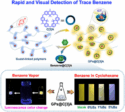Self-healing electronic materials can autonomically repair damage caused by external agents. Therefore, such materials are highly desirable for applications in artificial electronic skin or stretchable electronics. Among the organic conductive materials, poly(3,4-ethylenedioxythiophene) doped with polystyrene sulfonate (PEDOT:PSS) is of importance due to its high electrical conductivity, high air stability, and biocompatibility. However, its ability to self-heal has been left relatively unexplored.
Shiming Zhang and Fabio Cicoira, Polytechnique Montréal, Canada, have found that PEDOT:PSS thin films (>1 µm) show instantaneous electronic healing after wetting the damaged area with water. The healing process of the films was not affected by repeated damage to the film and occurred within 150 ms of wetting, making PEDOT:PSS thin films promising for use in self-healing circuits. It was also demonstrated that healing occurs after exposure to water vapor.
The team suggests that the healing process can be attributed to the swelling of PSS– chains upon exposure to water. The swollen PSS-chains swell towards the damage site, causing the PEDOT+ chains to shift and form conducting paths across the damage. The researchers further demonstrated the potential of PEDOT:PSS conductive polymers as ultrasensitive water leak sensors and as channel materials for self-healing organic electrochemical transistors.
- Water-Enabled Healing of Conducting Polymer Films,
Shiming Zhang, Fabio Cicoira,
Adv. Mater. 2017.
DOI: 10.1002/adma.201703098




